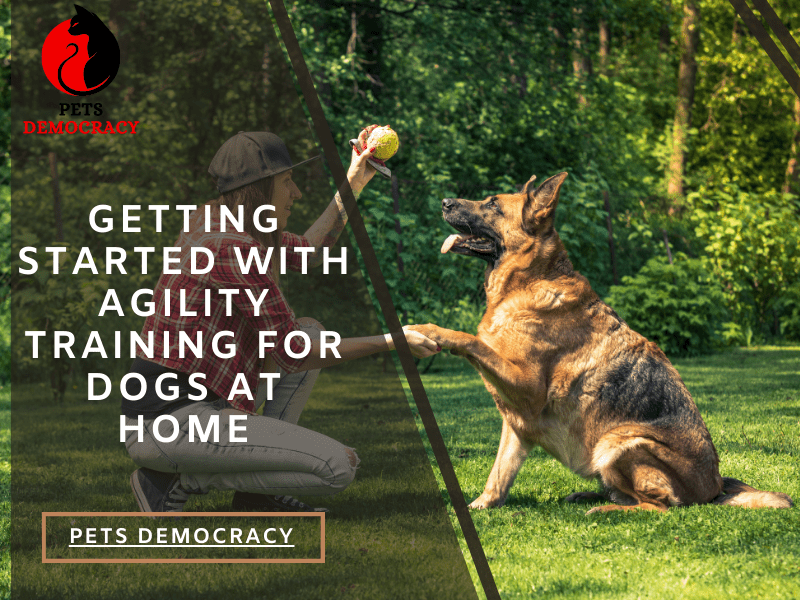
In this comprehensive guide, we’ll explore everything you need to know about agility training for dogs at home.
Are you looking for a fun and engaging way to bond with your furry friends while also keeping them mentally and physically stimulated? Look no further than agility training for dogs.
From understanding the benefits to learning essential techniques and exercises, we’ve got you covered. So, grab your pup, and let’s embark on this exciting journey together.
Understanding Agility Training for Dogs

Before we dive into the nitty-gritty details of agility training, let’s first understand what it entails. Agility training is a canine sport that involves navigating through a variety of obstacles such as jumps, tunnels, weave poles, and more, in a set sequence. It requires dogs to demonstrate speed, accuracy, and agility while following their handler’s cues.
Benefits of Agility Training for Dogs

Agility training offers a myriad of benefits for both you and your furry companion. Here are some of the key advantages:
Physical Exercise
Agility training for dogs, provides a full-body workout, helping them stay fit and healthy. It improves their strength, endurance, and flexibility, essential for overall well-being.
Mental Stimulation
Engaging in agility activities challenges dogs mentally as they have to problem-solve and make quick decisions while navigating through the course.
Bonding Opportunity
Agility training fosters a strong bond between dogs and their handlers. It requires teamwork, communication, and trust, to strengthen the relationship between you and your furry friend.
Confidence Boost
Successfully completing agility obstacles boosts dogs’ confidence and self-esteem. It empowers them to overcome challenges and reinforces positive behavior.
Getting Started with Agility Training for Dogs at Home

Now that you understand the benefits of agility training, it’s time to roll up your sleeves and get started. Here’s how you can set up an agility course in your own backyard and begin training your dog:
Create a Designated Space
Choose a spacious area in your backyard or a nearby park to set up your agility course. Ensure the space is free from obstacles and hazards that could pose a risk to your dog’s safety.
Gather Equipment
You’ll need a variety of agility equipment such as jumps, tunnels, weave poles, and a pause table. You can either purchase ready-made equipment or get creative and build your own using household items.
Start with Basic Commands
Before introducing your dog to the agility obstacles, make sure they have a solid foundation of basic obedience commands such as sit, stay, come, and heel. These commands will form the basis of your agility training.
Introduce One Obstacle at a Time
Begin by introducing your dog to one agility obstacle at a time. Use positive reinforcement techniques such as treats and praise to encourage them to approach and navigate the obstacle successfully.
Gradually Increase Difficulty
As your dog becomes more confident and skilled, gradually increase the difficulty of the obstacles by adding more complex sequences or raising the height of jumps. Always remember to keep the training sessions fun and engaging for your furry friend.
FAQs About Agility Training for Dogs
Q: Can any dog participate in agility training?
While agility training is suitable for most dogs, it’s important to consider your dog’s age, breed, and physical condition. Some breeds may be more predisposed to excel in agility due to their natural athleticism, but with proper training and conditioning, any dog can participate.
Q: How old does my dog need to be to start agility training?
Dogs can start agility training at any age, but it’s essential to wait until they fully develop physically and mentally. Typically, dogs can begin agility training around one year of age but always consult with your veterinarian to ensure it’s safe for your dog to participate.
Q: Do I need previous training experience to do agility training with my dog?
While previous training experience can be beneficial, it’s not a requirement to start agility training with your dog. With patience, dedication, and the right resources, anyone can learn to train their dog in agility.
Q: How often should I train my dog in agility?
The frequency of agility training sessions will depend on your dog’s individual needs and abilities. It’s important to strike a balance between training regularly to maintain progress and avoiding overexertion. Start with short, frequent sessions and adjust as needed based on your dog’s response.
Q: Can agility training help with behavioral issues in dogs?
es, agility training can be a valuable tool in addressing certain behavioral issues in dogs. The mental stimulation and physical exercise provided by agility training can help reduce anxiety, hyperactivity, and other problem behaviors.
Conclusion
Agility training for dogs at home offers a multitude of benefits, from physical exercise to mental stimulation and enhanced bonding with your furry companion.
By following the tips and techniques outlined in this guide, you can create a fun and rewarding agility training experience for both you and your dog. So, why wait? Start your agility journey today and unlock your canine companion’s full potential!
Agility training for dogs is not just a sport but also a fantastic way to keep your furry friend healthy, happy, and mentally stimulated.
With the right approach, patience, and dedication, you can transform your backyard into a thrilling agility course where you and your dog can embark on countless adventures together.


